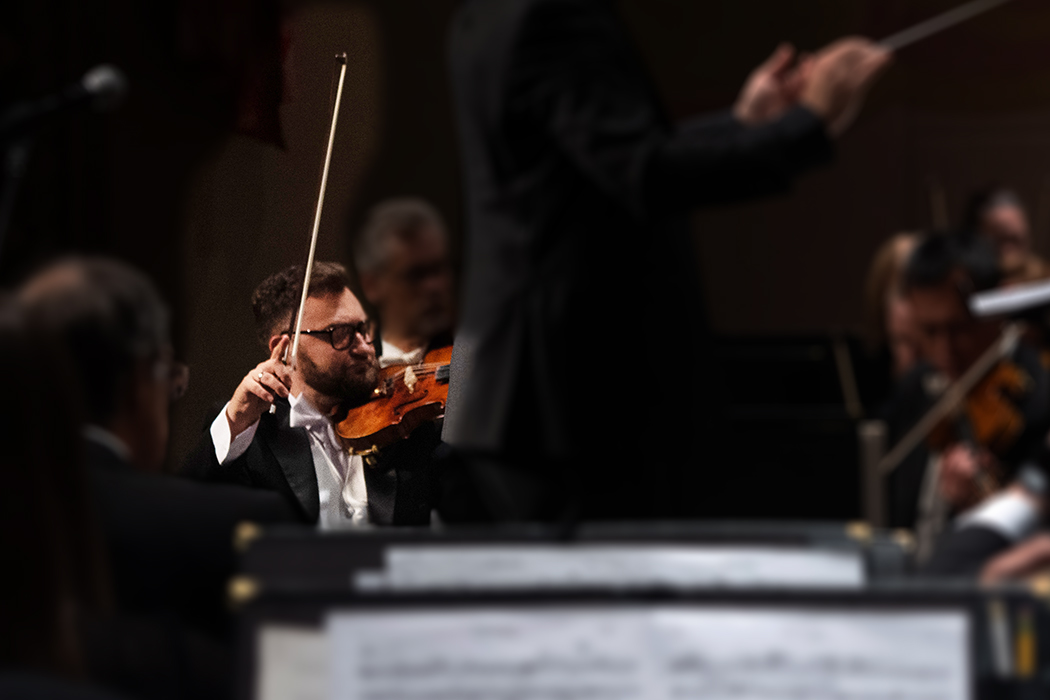William Shaub plays on one of the finest violins in the world – an 1865 Jean-Baptiste Vuillaume. When he takes the stage of the Tennessee Theatre on January 25-26 as Concertmaster of the Knoxville Symphony Orchestra, he will carry his beloved Vuillaume. But a second violin will await him, carefully placed on a bench near his orchestral chair. And for this added layer of orchestral complexity, we can thank composer Gustav Mahler, whose classic Symphony No. 4 is about to be heard in Knoxville for the first time in over 20 years.
Mahler, of all people. It’s hard to imagine why a composer would require a single violinist to perform on two instruments over the course of one symphony. Was Mahler a sadist? Genius? Prankster? All of the above?
I’m going with genius. You see, Mahler wrote a violin solo for his fourth symphony, but he didn’t want it to sound like any ordinary violin solo. He wanted it to sound like a fiddle. And a “deathly” sounding fiddle at that.

He started by requiring the solo violin to be tuned completely differently than a regular violin. Shaub’s Vuillaume strings will be pitched, from bottom to top, at G, D, A, and E – which is how violins are supposed to be tuned. Shaub’s second violin, which he will pick up for the deathly solos, will be ratcheted one step higher, so, A, E, B, and F sharp.
This alternate method of tuning, called scordatura (or “discord” in English), has been used as far back as the Baroque period. It’s a rarity, however, and poses myriad problems. The first is that the music is notated based on the notes the violinist expects to hear when placing down fingers on a properly tuned violin.
Let’s have Shaub explain. “If I put my index finger down on the second string of my regular violin, I get a B natural. If I put my index finger down on the second string of my alternatively tuned violin, I get a C sharp.”
Rather than ask the violinist to abandon decades of muscle memory, Mahler writes the notes based on the fingerings. Shaub continues, “Mahler knows a violinist who sees a printed B natural will automatically put down his first finger on the second string. So, if Mahler wants to hear a C sharp, he prints a B natural. Bottom line – the notes I see printed on the page are not the notes I hear.”
This is confusing, at best, and a nightmare, at worst, for those players with perfect pitch.
Further, by being tuned to a higher level than the violin was designed to be tuned, the violin’s sound becomes more strident and intense. Which is exactly what Mahler is going for. As Shaub explains, “This particular scordatura gives the violin a darker quality, one in which the violin becomes a character in the piece – a character that is a bit more sinister.” In this context, Shaub must become an actor playing a part, rather than simply a violinist playing his instrument.
Shaub is fortunate (as is the rest of the violin world in East Tennessee) to have a violin shop directly across the street from the Tennessee Theater. Luthier Wesley Rule of Knoxville Fine Violins loaned Shaub an instrument that was up to this daunting task – a modern Italian violin dated 1915 (yes, that is modern in violin years). Says Shaub, “Tuning upwards like this, you lose a lot of what is good about the violin’s sound. The higher-tuned instrument equalizes the sound from violin to violin, and not in a good way. You need to start with a healthy instrument that can take the extra pressure. And then hope to heaven your E string doesn’t break under the strain!”
A few other distinguishing features of Mahler’s fourth. It is about an hour in length, making it one of Mahler’s shorter symphonies. It features a soprano soloist in the final movement – Laura Strickling for the KSO performances. The orchestration is smaller and somewhat classical in feel, but features sleighbells as an enchanting flavor. And members of the brass and wind sections will be on prominent display. (Spoiler alert: The horn solos are tremendous!)
Mahler said of his Symphony No. 4 that it is “…quite fundamentally different from my other symphonies. But that must be. I could never repeat a state of mind – and as life drives on, so too I follow new tracks in every work.”
And we, dear Gustav, will be right behind you.
• • • • • • •
The first half of the concert will feature the Knoxville Symphony Youth Orchestra—conducted by James Fellenbaum—celebrating its 50th anniversary with works by Tchaikovsky, Jesse Montgomery, Engelbert Humperdinck, and Georges Bizet. The Mahler Symphony No. 4—conducted by Aram Demirjian— follows on the second half.








Excellent article. Thank you.
Mignon